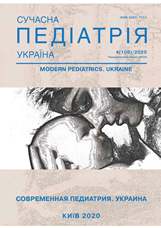Peculiarities of the state of the cardiovascular system in patients with juvenile idiopathic arthritis
Keywords:
children, juvenile idiopathic arthritis, electrocardiography, cardiovascular lesionsAbstract
Juvenile idiopathic arthritis (JIA) is a common childhood rheumatic chronic disease. Today, the possibilities of its diagnosis, treatment and rehabilitation in the world are at a fairly high level. However, the issue of combating long-term extra0articular consequences is still open, and the first place in the structure of mortality in patients with rheumatic diseases belongs to the lesions of the cardiovascular system (CVS). Thus, the early detection of such lesions at the preclinical stage is relevant for improving the quality and longevity of patients.
Purpose — to study changes in the CVS in patients with JIA depending on its phenotype.
Materials and methods. Clinical, laboratory and instrumental examination of patients who were treated at the State Institution «IPOG named after academician OM Lukyanova of the NAMS of Ukraine» was performed. Statistical processing of data from medical records of these patients was made.
Results. A comparative characteristic of the subvariants of JIA in the population of the examined patients is provided. There was a lack of correlation of changes in the 12-channel ECG with indicators of laboratory and clinical activity of the disease. The detected changes on the ECG are, with some exceptions, non-specific and cannot be used as a predictor of the development of secondary processes as a result of systemic inflammation.
Conclusions. The methods of instrumental, laboratory and clinical assessment, which are routinely used in the examination of patients with JIA, do not fully assess the patient's potential tendency to develop threatening lesions of the CVS, regardless of the sub0variants of the disease.
The research was carried out in accordance with the principles of the Helsinki Declaration. The study protocol was approved by the Local Ethics Committee of these Institutes. The informed consent of the patient was obtained for conducting the studies.
References
Angeles-Han ST, Ringold S, Beukelman T et al. (2019). American College of Rheumatology/Arthritis Foundation Guideline for the Screening, Monitoring, and Treatment of Juvenile Idiopathic Arthritis-Associated Uveitis. Arthritis Care Res. 71: 703–716. https://doi.org/10.1002/acr.23871; PMid:31021540 PMCid:PMC6777949
Antypkin YuH, Volosovets OP, Maidannyk VH ta in. (2018). Stan zdorov'ia dytiachoho naselennia – maibutnie krainy (chastyna 2). Zdorov'ia dytyny. 13 (2): 142–152.
Barut K, Adrovic A, Sahin S, Kasapcopur O. (2017). Juvenile Idiopathic Arthritis. Balkan medical journal. 34 (2): 90–101. https://doi.org/10.4274/balkanmedj.2017.0111; PMid:28418334 PMCid:PMC5394305
Consolaro A, Ruperto N, Bazso A, Pistorio A, Magni-Manzoni S, Filocamo G et al. (2009). Paediatric Rheumatology International Trials Organisation. Development and validation of a composite disease activity score for juvenile idiopathic arthritis. Arthritis Rheum. 61: 658–666. https://doi.org/10.1002/art.24516; PMid:19405003
Paediatric Rheumatology International Trials Organisation. (2018). Information on Paediatric Rheumatic Diseases. URL: https://www.printo.it/pediatric-rheumatology/GB/info/2/Juvenile-Idiopathic-Arthritis.
Peters MJL, Symmons DPM, McCarey D et al. (2010). EULAR evidence-based recommendations for cardiovascular risk management in patients with rheumatoid arthritis and other forms of inflammatory arthritis. Annals of the Rheumatic Diseases. 69: 325–331.
Ravelli A, Martini A. (2007). Juvenile idiopathic arthritis. Lancet. 369 (9563): 767–778. https://doi.org/10.1016/S0140-6736(07)60363-8
Ravelli A, Consolaro A, Horneff G et al. (2018). Treating juvenile idiopathic arthritis to target: recommendations of an international task force. Annals of the Rheumatic Diseases. 77: 819–828.
Ringold S, Angeles–Han ST, Beukelman et al. (2019). American College of Rheumatology/Arthritis Foundation Guideline for the Treatment of Juvenile Idiopathic Arthritis: Therapeutic Approaches for Non-Systemic Polyarthritis, Sacroiliitis, and Enthesitis. Arthritis Rheumatol. 71: 846–863. https://doi.org/10.1002/art.40884; PMid:31021537 PMCid:PMC6561114
Schoemaker CG, Swart JF, Wulffraat NM. (2020, Apr 16). Treating juvenile idiopathic arthritis to target: what is the optimal target definition to reach all goals? Pediatr Rheumatol Online J. 18 (1): 34. https://doi.org/10.1186/s12969-020-00428-7; PMid:32299430 PMCid:PMC7164231
Downloads
Published
Issue
Section
License
The policy of the Journal “MODERN PEDIATRICS. UKRAINE” is compatible with the vast majority of funders' of open access and self-archiving policies. The journal provides immediate open access route being convinced that everyone – not only scientists - can benefit from research results, and publishes articles exclusively under open access distribution, with a Creative Commons Attribution-Noncommercial 4.0 international license (СС BY-NC).
Authors transfer the copyright to the Journal “MODERN PEDIATRICS. UKRAINE” when the manuscript is accepted for publication. Authors declare that this manuscript has not been published nor is under simultaneous consideration for publication elsewhere. After publication, the articles become freely available on-line to the public.
Readers have the right to use, distribute, and reproduce articles in any medium, provided the articles and the journal are properly cited.
The use of published materials for commercial purposes is strongly prohibited.

